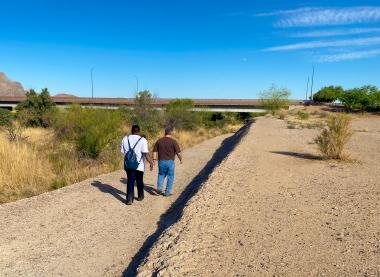Virtual reality project brings accessibility to environmental field sciences
Dr. Jackie Maximillian partners with Center for Digital Humanities to bring research to underrepresented scientific communities
Abarca & Maximillian.jpg

A University of Arizona student puts on their virtual reality (VR) headset and enters the Santa Cruz river, ready to take water samples while studying thousands of miles away — that is the vision of one Environmental Science professor and her team.
Dr. Jacqueline “Jackie” Maximillian, a UArizona associate professor of practice in the Environmental Science department, saw an opportunity for a better academic experience for her online research students by using VR technology. She partnered with the Center for Digital Humanities (CDH), earned a grant, and began the project at the beginning of the fall 2022 semester.
Use your mouse to move point of view of the 360-degree video
While Maximillian’s initial intent was to improve research accessibility for online students, she quickly realized the possibilities of increased accessibility for other groups of students as well.
“In my career, I see there are groups of people who are underrepresented in the lab and in the field,” Maximillian said. “Especially when it comes to BIPOC and disabled students, they don’t have the same access to field research that other students do and I want to help change that.”
Maximillian realized a virtual reality research opportunity can also help LGBTQ students and researchers, who experience more harassment in the field than others.
By creating demonstrative videos recorded with 360-degree cameras, creating 3D scans, and developing an interactive online course, Maximillian knew she could help all of these students gain entry into a historically obstacle-filled field. The only problem — she didn’t know how to use this technology.
“The first time I heard the term ‘virtual reality’ I said, ‘What is that?’” Maximillian joked. “But I connected with Dr. Bryan Carter from the Center for Digital Humanities, and he showed me what we could do, and I loved the idea.”
2 Cosmo Zappellini

The Center for Digital Humanities, which Carter directs, is an innovative center on UArizona campus that uses digital technologies to provide creative, scholarly, and educational support for the campus and local communities.
Carter brought the idea back to the Center with two undergraduate students, Jennifer Abarca and Cosmo Zappellini, in mind.
“Since I picked up my first computer, I knew I wanted to work with art and technology,” Abarca, a junior majoring in studio art, said. “And since I joined CDH, I have been dying to join a project where I got to see it from beginning to end, so this was perfect for me.”
Abarca specializes in 3D and extended media art, as well managing projects for the Center for Digital Humanities, while Zappellini specializes in 360-video capture and editing.
“With our current state of the world growing online, and for the students who felt left behind in their education with the pandemic, the more we can simulate an educational experience that is engaging, entertaining, and educating, the more we can help all those students who feel lost,” Zappellini said.
Maximillian recruited two Environmental Science faculty members to help kickstart the project: Dr. Rivka Fidel and Dr. Scott Cowell.
Fidel, an associate professor of practice who specializes in soil science, also teaches online labs and needed more interactive ideas for her students. By helping with the virtual reality program, she would help accomplish Maximillian’s goals while simultaneously producing interactive content for her own class, a “win-win” according to Fidel.
“There is this preconception that certain fields, like soil science, can’t be taught remotely,” Fidel said. “But when you think outside of the box, we can be pioneering in that direction.”
3 Maximillian & Cowell.jpg

For students pursuing soil science careers in Arizona, Fidel said that it is important for them to have experience with Arizona soils, posing a problem for out-of-state online students. But with the virtual reality program, the team is producing 3D scans of real soil profiles from the Santa Cruz River for students to interact with on a headset.
“Soil science is something that is very localized, so it is vital for students to see desert and floodplain soils,” Fidel said. “A lot of students don’t have the opportunity for a field trip and characterizing a soil profile is a lot different than digging a hole in your backyard or analyzing soil sent to them. With VR, they get to come to Arizona virtually and look at some real soil here in Tucson."
Although it is an unusual pairing, the Environmental Science department and the Center for Digital Humanities teaming up for the first time, the duo is bringing new perspectives to each of their fields.
“The fact that we are working with students on this is a bonus,” Maximillian said. “Our faculty can make these designs and courses, but it is these students who will be using it. They understand how students learn and what excites them.”
Maximillian also highlighted the importance of having an art perspective from Abarca and Zappellini, which she said brings a new “flavor” to science.
The team is currently product testing with a small group of students, and hopes to bring the project to the classroom in spring 2023.

